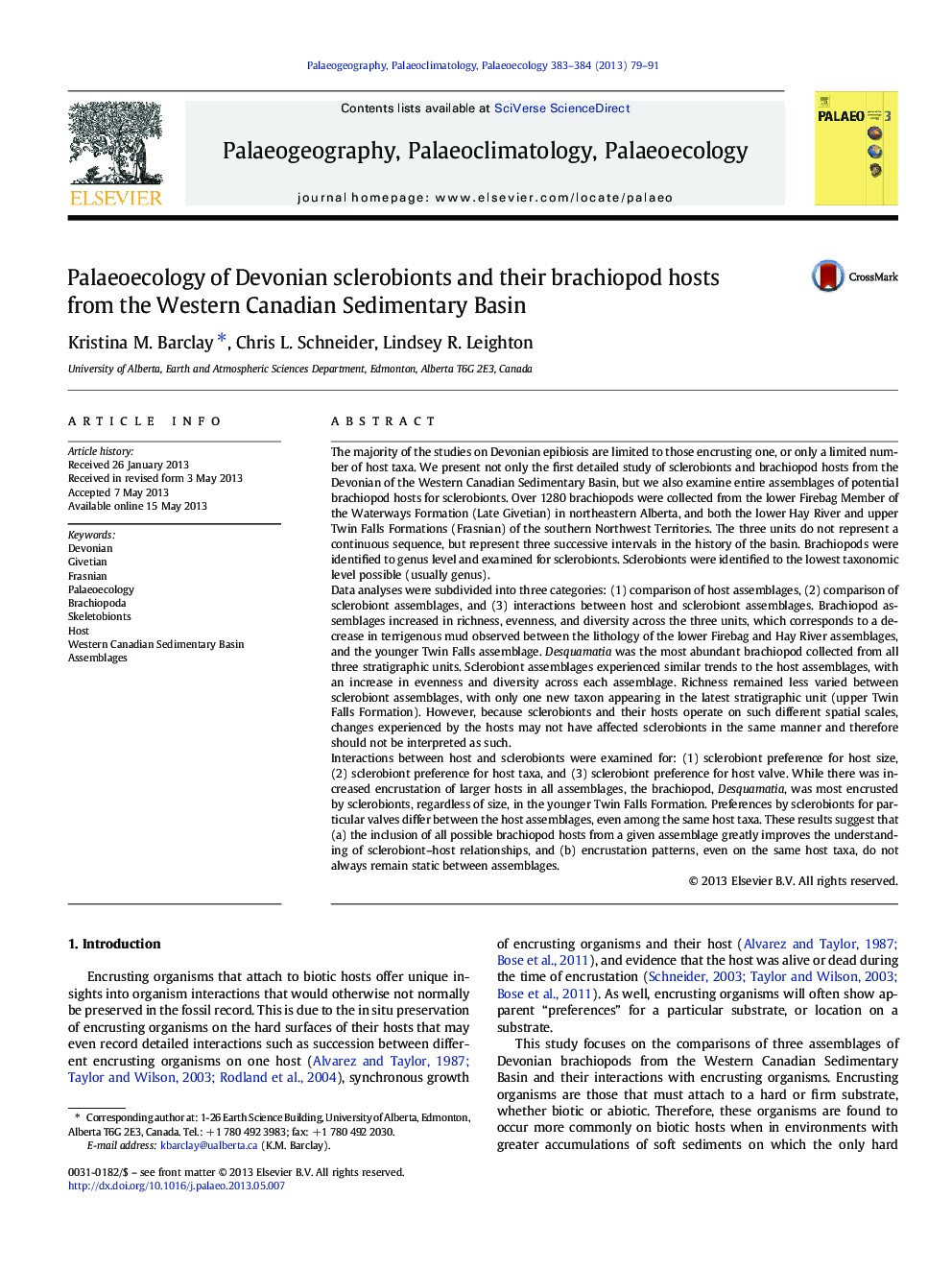| کد مقاله | کد نشریه | سال انتشار | مقاله انگلیسی | نسخه تمام متن |
|---|---|---|---|---|
| 4466551 | 1622205 | 2013 | 13 صفحه PDF | دانلود رایگان |

• We compare three assemblages of brachiopod hosts and their sclerobionts.
• Diversity metrics of brachiopod assemblages correspond to terrigenous mud input.
• Sclerobiont assemblages do not experience the same changes as host assemblages.
• Sclerobiont preferences do not remain consistent between assemblages.
• It is important to consider multiple assemblages of both sclerobionts and hosts.
The majority of the studies on Devonian epibiosis are limited to those encrusting one, or only a limited number of host taxa. We present not only the first detailed study of sclerobionts and brachiopod hosts from the Devonian of the Western Canadian Sedimentary Basin, but we also examine entire assemblages of potential brachiopod hosts for sclerobionts. Over 1280 brachiopods were collected from the lower Firebag Member of the Waterways Formation (Late Givetian) in northeastern Alberta, and both the lower Hay River and upper Twin Falls Formations (Frasnian) of the southern Northwest Territories. The three units do not represent a continuous sequence, but represent three successive intervals in the history of the basin. Brachiopods were identified to genus level and examined for sclerobionts. Sclerobionts were identified to the lowest taxonomic level possible (usually genus).Data analyses were subdivided into three categories: (1) comparison of host assemblages, (2) comparison of sclerobiont assemblages, and (3) interactions between host and sclerobiont assemblages. Brachiopod assemblages increased in richness, evenness, and diversity across the three units, which corresponds to a decrease in terrigenous mud observed between the lithology of the lower Firebag and Hay River assemblages, and the younger Twin Falls assemblage. Desquamatia was the most abundant brachiopod collected from all three stratigraphic units. Sclerobiont assemblages experienced similar trends to the host assemblages, with an increase in evenness and diversity across each assemblage. Richness remained less varied between sclerobiont assemblages, with only one new taxon appearing in the latest stratigraphic unit (upper Twin Falls Formation). However, because sclerobionts and their hosts operate on such different spatial scales, changes experienced by the hosts may not have affected sclerobionts in the same manner and therefore should not be interpreted as such.Interactions between host and sclerobionts were examined for: (1) sclerobiont preference for host size, (2) sclerobiont preference for host taxa, and (3) sclerobiont preference for host valve. While there was increased encrustation of larger hosts in all assemblages, the brachiopod, Desquamatia, was most encrusted by sclerobionts, regardless of size, in the younger Twin Falls Formation. Preferences by sclerobionts for particular valves differ between the host assemblages, even among the same host taxa. These results suggest that (a) the inclusion of all possible brachiopod hosts from a given assemblage greatly improves the understanding of sclerobiont–host relationships, and (b) encrustation patterns, even on the same host taxa, do not always remain static between assemblages.
Journal: Palaeogeography, Palaeoclimatology, Palaeoecology - Volumes 383–384, August 2013, Pages 79–91